Limb Regeneration Histology in Notophthalmus viridescens
A photo series by Jennifer Macke
These photos show thin sections through limbs during the process of regeneration. The series includes limbs only in the early stages of regenerating: 4 - 26 days. By day 26, the limb is beginning to regrow, but not yet fully formed and does not yet include new toes. The following processes can be observed in the early stages: wound healing, dedifferentiation, blastema accumulation, and early redifferentiation. These terms are explained in the text with the images below. For each image, a larger image is available by clicking the photo.
All sections were prepared at a thickness of 8 µm. Slides were stained with Pico-Mallory multiple contrast stain. This set of stains produces colors that are not typical of the usual H&E tissue staining. Nuclei appear red, blood cells are orange, and connective tissues are blue. Bone is typically blue, but staining produces some areas that appear red-on-blue.
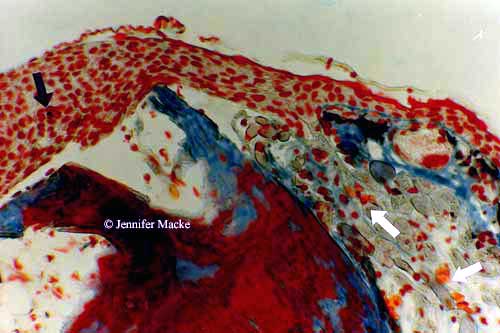 |
Day 4. (The "end" of the limb points toward the upper left of the photo.) Within a day or two after amputation, a layer of epidermis (skin) has completely covered the wound. By day 4, a thick epithelial cap has formed, and pigment cells begin to appear in it (black arrow). Note that the broken end of the bone is still directly under the epithelium, and red blood cells (white arrows) are loose in the tissue, not entirely confined to blood vessels. A lot of debris is present. Magnification 170X. |
 |
Day 9. At this stage, the epithelium has relaxed and thickened. Free blood cells are still seen. The bone near the tip has begun to be degraded (white arrows), and cells are now present between the bone and the epidermis. At this stage, cells that will form the blastema (black arrows) have begun to accumulate. The blastema is a mass of undifferentiated (i.e., nondescript) cells that will later rebuild all the limb tissues. Magnification 250X. |
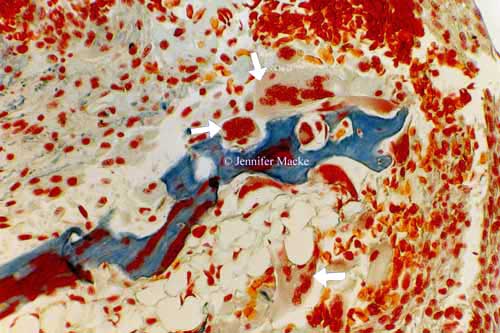 |
Day 14. (The "end" of the limb points toward the upper right. The torn epithelium is an artifact.) Bone continues to be degraded, a task accomplished by osteoclasts (white arrows), which are large multi-nucleated cells. Magnification 170X. |
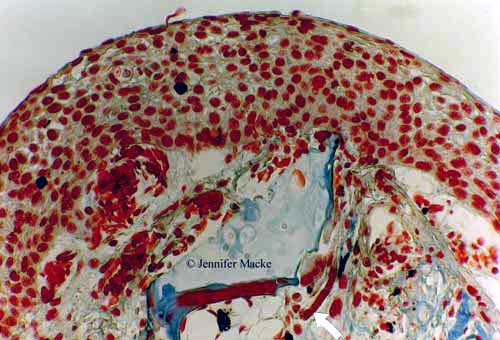 |
Day 14. Note dedifferentiating bone, dedifferentiating muscle (white arrow), sparce scattered blastema cells, and the restriction of blood cells to vessels. Also, the epithelial cap can be quite thick, as in this example. Magnification 170X. |
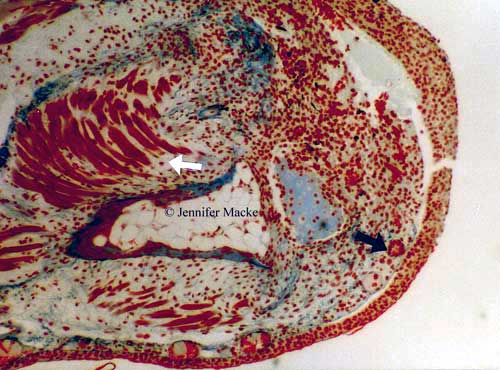 |
Day 20. The torn epithelium is an artifact, and this section shows some edema (fluid build up between the epithelium and underlying blastema). Note prominent dedifferentiation of muscle (white arrow). Remaining bone now has smooth edges, indicating the completion of dedifferentiation. By this stage, all blood is confined to vessels, and the limb tip begins to develop new skin glands (black arrow). These skin glands provide the normal external lubrication of amphibian skin. Magnification 80X. |
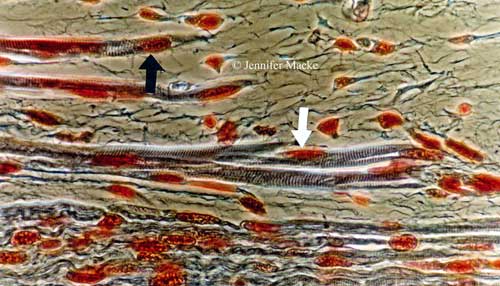 |
Day 26. Close-up of dedifferentiating muscle. Note that normal flattened muscle nuclei (white arrow) become more rounded (black arrow), and muscle fibers degrade. Magnification 370X phase contrast. |
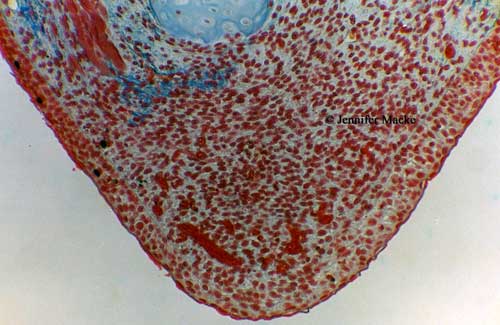 |
Day 26. (The "end" of the limb is pointed down.) By this point, the blastema is growing rapidly (large area of nondescript cells under the epithelium). From the outside, this can give the limb a pointed appearance (see other photo series). As regeneration progresses, blastema cells will redifferentiate into new muscle, bone, etc. Magnification 120X. |
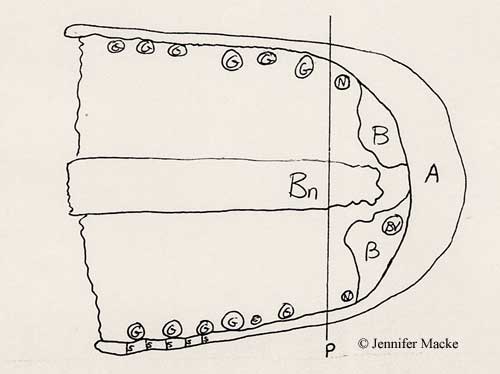 |
Day 30+. Schematic diagram of a section through a newt limb during the process of regrowth. P=plane of amputation; Bn=bone; B=blastema; Bv=blood vessel; A=epidermis; G=skin gland; N=new skin gland. |








